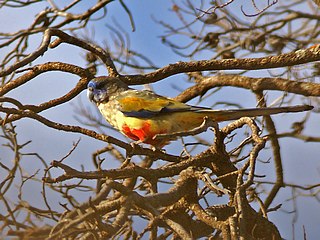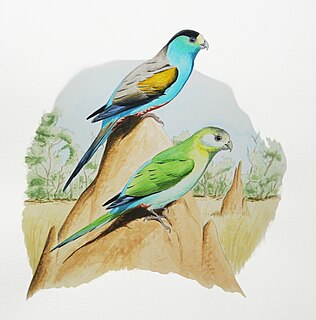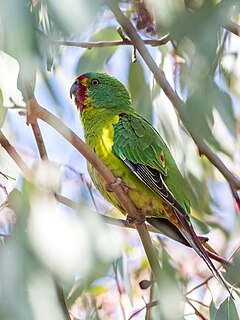 W
WThe term bluebonnet refers to the two species of Australian parrots in the genus Northiella. The genus name honours Australian ornithologist Alfred John North.
 W
WThe eastern bluebonnet, also known as the greater bluebonnet, is an Australian parrot, one of two species in the genus Northiella. It was originally included in the genus Psephotus but due to distinctive physical and behavioural differences was reclassified into its own genus in 1994 by ornithologists and taxonomists Christidis and Boles. The bluebonnet is a medium-sized inland parrot commonly found in the interior of southeastern and central-southern Australia. It is adapted to life in semi-arid regions but can also flourish in regions of medium rainfall towards the eastern and southern extremities of its range.
 W
WThe green rosella or Tasmanian rosella is a species of parrot native to Tasmania and Bass Strait islands. It was described by the German naturalist Johann Friedrich Gmelin in 1788, and named on the mistaken assumption it came from New Caledonia. At 37 cm (14.5 in) long it is the largest species of the rosella genus, Platycercus. Two subspecies are recognised. The green rosella's underparts, neck and head are yellow, with a red band above the beak and violet-blue cheeks. The back is mostly black and green, and its long tail blue and green. The sexes have similar plumage, except the female has duller yellow plumage and more prominent red markings, as well as a smaller beak. Juvenile and immature birds have predominantly green plumage.
 W
WThe Naretha bluebonnet is an Australian parrot, one of two species in the genus Northiella. It is closely related to, and was considered a subspecies of, the eastern bluebonnet.
 W
WThe paradise parrot, species Psephotellus pulcherrimus, was a colourful medium-sized parrot native to the grassy woodlands of the Queensland – New South Wales border area of eastern Australia. Once moderately common within its fairly restricted range, the last live bird was seen in 1927. Extensive and sustained searches in the years since then have failed to produce any reliable evidence of it, and it is the only Australian parrot recorded as disappearing and presumed extinct.
 W
WThe golden-shouldered parrot, also known as the alwal, is a rare bird of southern Cape York Peninsula, in Queensland, Australia. A small parrot related to the more common red-rumped parrot, it is considered to be a superspecies with the hooded parrot (P. dissimilis) of the Northern Territory and the apparently extinct paradise parrot of Queensland and New South Wales.
 W
WThe mulga parrot is endemic to arid scrublands and lightly timbered grasslands in the interior of southern Australia. The male mulga parrot is multicolored, from which the older common name of many-coloured parrot is derived.
 W
WThe genus Pezoporus contains three Australian species: the night parrot and the cryptic ground parrots, the eastern ground parrot and the western ground parrot. The night parrot was previously separated in a distinct genus, Geopsittacus. The genus is part of the tribe Pezoporini.
 W
WPsephotellus is a genus of four species of Australian parakeets. All species show considerable sexual dimorphism. These species have traditionally been placed in the genus Psephotus along with the red-rumped parrot, but a molecular study analysing nuclear and mitochondrial DNA found that the red-rumped parrot was an early offshoot in a clade of several genera of broad-tailed parrot, with the other species nested deeply within.
 W
WThe red-rumped parrot, also known as the red-backed parrot or grass parrot, is a common bird of south-eastern Australia, particularly in the Murray-Darling Basin.
 W
WAustralian ringneck, the broad-tailed parrot species Barnardius zonarius, is a bird native to Australia. Except for extreme tropical and highland areas, the species has adapted to all conditions. Treatments of genus Barnardius have previously recognised two species, the Port Lincoln parrot and the mallee ringneck, but due to these readily interbreeding at the contact zone they are usually regarded as a single species B. zonarius with subspecific descriptions. Currently, four subspecies are recognised, each with a distinct range.
 W
WThe crimson rosella is a parrot native to eastern and south eastern Australia which has been introduced to New Zealand and Norfolk Island. It is commonly found in, but not restricted to, mountain forests and gardens. The species as it now stands has subsumed two former separate species, the yellow rosella and the Adelaide rosella. Molecular studies show one of the three red-coloured races, P. e. nigrescens, is genetically more distinct.
 W
WThe eastern rosella is a rosella native to southeast of the Australian continent and to Tasmania.
 W
WThe pale-headed rosella, is a broad-tailed parrot of the genus Platycercus native to northeastern Australia. It is a moderate-size parrot with a pale yellow head, predominantly white cheeks, scalloped black and gold back and pale blue underparts. Two subspecies are recognised, although some authorities consider it to be conspecific with the eastern rosella of southeastern Australia.
 W
WThe swift parrot, also known as red-faced parrot or red-shouldered parrot breeds in Tasmania and migrates north to south eastern Australia from Griffith-Warialda in New South Wales and west to Adelaide in the winter. It is related to the rosellas, with the feeding habits of a lorikeet. It is the only member in the genus Lathamus.